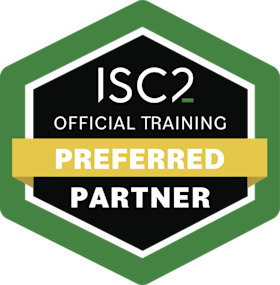What you’ll learn
The Certified Secure Software Lifecycle Professional (CSSLP) validates that software professionals have the expertise to incorporate security practices – authentication, authorisation and auditing – into each phase of the software development lifecycle (SDLC), from software design and implementation to testing and deployment.
ISC2 at Lumify Work
ISC2: The world’s leading cyber security and IT security professional organisation. Lumify Work is one of only a few select training providers in Australia with campuses in New Zealand and the Philippines. We offer official ISC2 courses and training materials.
Who is the course for?
The ISC2 CSSLP is ideal for software development and security professionals responsible for applying best practices to each phase of the SDLC – from software design and implementation to testing and deployment – including those in the following positions:
Course subjects
The broad spectrum of topics included in the CSSLP Common Body of Knowledge (CBK®) ensure its relevancy across all disciplines in the field of information security.
This course provides in-depth coverage of the eight domains required to prepare for the CSSLP exam. Refer to the CSSLP Exam Outline for a deeper dive into the CSSLP domains.
1. Secure Software Concepts
2. Secure Software Requirements
Define Software Security Requirements
Identify and Analyse Compliance Requirements
Identify and Analyse Data Classification Requirements
Identify and Analyse Privacy Requirements
Develop Misuse and Abuse Cases
Develop Security Requirement Traceability Matrix (STRM)
Ensure Security Requirements Flow Down to Suppliers/Providers
3. Secure Software Architecture and Design
Perform Threat Modeling
Define the Security Architecture
Performing Secure Interface Design
Performing Architectural Risk Assessment
Model (Non-Functional) Security Properties and Constraints
Model and Classify Data
Evaluate and Select Reusable Secure Design
Perform Security Architecture and Design Review
Define Secure Operational Architecture (e.g., deployment topology, operational interfaces)
Use Secure Architecture and Design Principles, Patterns, and Tools
4. Secure Software Implementation
Adhere to Relevant Secure Coding Practices (e.g., standards, guidelines and regulations)
Analyse Code for Security Risks
Implement Security Controls (e.g., watchdogs, File Integrity Monitoring (FIM), anti-malware)
Address Security Risks (e.g. remediation, mitigation, transfer, accept)
Securely Reuse Third-Party Code or Libraries (e.g., Software Composition Analysis (SCA))
Securely Integrate Components
Apply Security During the Build Process
5. Secure Software Testing
Develop Security Test Cases
Develop Security Testing Strategy and Plan
Verify and Validate Documentation (e.g., installation and setup instructions, error messages, user guides, release notes)
Identify Undocumented Functionality
Analyse Security Implications of Test Results (e.g., impact on product management, prioritisation, break build criteria)
Classify and Track Security Errors
Secure Test Data
Perform Verification and Validation Testing
6. Secure Software Lifecycle Management
Secure Configuration and Version Control (e.g., hardware, software, documentation, interfaces, patching)
Define Strategy and Roadmap
Manage Security Within a Software Development Methodology
Identify Security Standards and Frameworks
Define and Develop Security Documentation
Develop Security Metrics (e.g., defects per line of code, criticality level, average remediation time, complexity)
Decommission Software
Report Security Status (e.g., reports, dashboards, feedback loops)
Incorporate Integrated Risk Management (IRM)
Promote Security Culture in Software Development
Implement Continuous Improvement (e.g., retrospective, lessons learned)
7. Secure Software Deployment, Operations, Maintenance
Perform Operational Risk Analysis
Release Software Securely
Securely Store and Manage Security Data
Ensure Secure Installation
Perform Post-Deployment Security Testing
Obtain Security Approval to Operate (e.g., risk acceptance, sign-off at appropriate level)
Perform Information Security Continuous Monitoring (ISCM)
Support Incident Response
Perform Patch Management (e.g. secure release, testing)
Perform Vulnerability Management (e.g., scanning, tracking, triaging)
Runtime Protection (e.g., Runtime Application Self-Protection (RASP), Web Application Firewall (WAF), Address Space Layout Randomisation (ASLR))
Support Continuity of Operations
Integrate Service Level Objectives (SLO) and Service Level Agreements (SLA) (e.g., maintenance, performance, availability, qualified personnel)
8. Secure Software Supply Chain
Implement Software Supply Chain Risk Management
Analyse Security of Third-Party Software
Verify Pedigree and Provenance
Ensure Supplier Security Requirements in the Acquisition Process
Support contractual requirements (e.g., Intellectual Property (IP) ownership, code escrow, liability, warranty, End-User License Agreement (EULA), Service Level Agreements (SLA))
Prerequisites
To qualify for this certification, you must pass the exam and have at least four years of cumulative, paid work experience as a software development lifecycle professional in one or more of the eight domains of the ISC2 CSSLP Common Body of Knowledge.
A relevant four-year degree can satisfy one year of required experience. Learn more about the ISC2 CSSLP Experience Requirements.
A candidate who doesn’t have the required experience to become a CSSLP may become an Associate of ISC2 by successfully passing the CSSLP exam. An Associate of ISC2 can then accumulate the necessary work experience to achieve full certification.
FREE E-BOOK: Meeting the Cyber Security Challenge
What are the top challenges in cyber security? Gain insight into how organisations can address challenges through cyber security training programs that build a skilled and diverse cyber workforce.
Terms & Conditions
The supply of this course by Lumify Work is governed by the booking terms and conditions. Please read the terms and conditions carefully before enrolling in this course, as enrolment in the course is conditional on acceptance of these terms and conditions.


